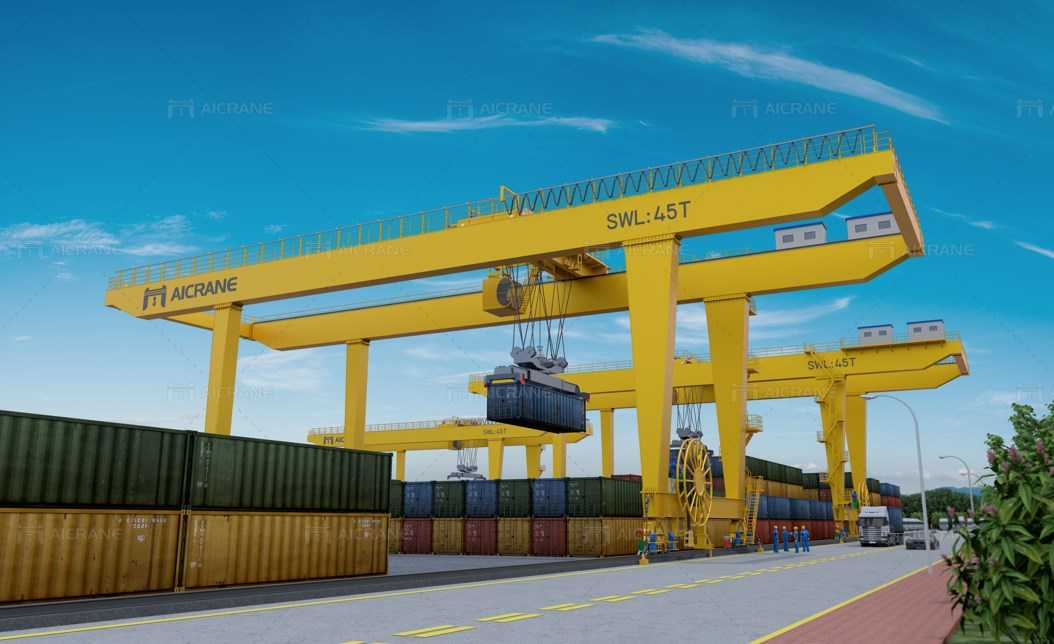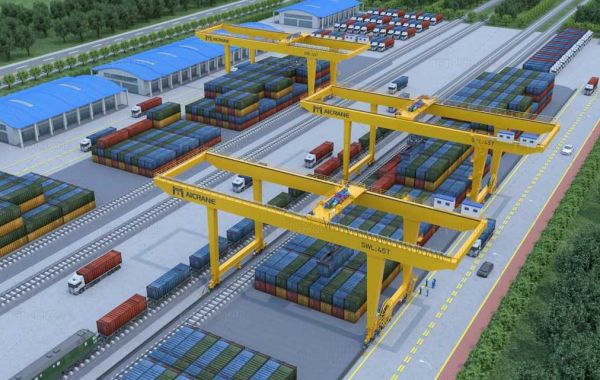Rail Mounted Gantry (RMG) cranes are critical for container handling, cargo transfer, and other heavy-duty applications in ports, intermodal yards, and industrial environments. When selecting an RMG crane, understanding its key parameters—particularly lifting height and span—is essential. These two factors significantly influence the crane's performance, operational efficiency, and suitability for specific tasks. This article explores the importance of lifting height and span in RMG cranes, discussing their impact on crane operations and providing insights into how to choose the right specifications.
What are Rail Mounted Gantry Cranes?
Rail Mounted Gantry cranes are large lifting machines that operate on rails fixed to the ground. Unlike rubber-tired gantry cranes, which are mobile and can move freely on wheels, rail mounted cranes are restricted to fixed rail tracks. This limitation is compensated by their ability to handle high loads with precision and efficiency. RMG cranes are often used for loading and unloading containers, handling bulk materials, and lifting heavy machinery in various settings.

Understanding Key Parameters of RMG Cranes
1. Lifting Height
Lifting height refers to the vertical distance the hoist can travel from the ground to the maximum height it can reach. It is a crucial parameter that determines the crane's ability to lift containers or loads to a specific height. The lifting height is particularly important in environments where vertical space utilization is critical, such as in container terminals, where containers are often stacked in multiple tiers.
Why is Lifting Height Important?
Stacking Capacity: In container yards, maximizing storage capacity is essential. The lifting height determines how many containers can be stacked on top of each other, directly impacting the yard's capacity. Higher lifting heights allow for taller stacks, which can lead to more efficient use of space.
Operational Flexibility: A greater lifting height enables the crane to handle different types of containers, including taller containers or oversized loads. This flexibility is beneficial in ports and terminals where a variety of cargo types must be managed.
Safety Considerations: Proper lifting height ensures safe operations by providing adequate clearance between the crane and other structures, vehicles, or equipment in the yard. Insufficient lifting height may lead to collisions or operational hazards.
Efficient Load Handling: The ability to lift loads to a suitable height is crucial for efficient loading and unloading processes. For example, when transferring containers from ships to storage yards, a higher lifting height facilitates smoother and quicker operations.
Factors Affecting the Choice of Lifting Height
- Stacking Needs: If the primary use of the RMG crane is to stack containers in a busy port, the required lifting height should be based on the maximum number of tiers planned for stacking.
- Load Dimensions: For facilities handling oversized cargo or heavy machinery, a higher lifting height may be necessary to accommodate the specific dimensions of the load.
- Yard Layout: The arrangement of storage areas, equipment, and other infrastructure within the yard can influence the required lifting height.
2. Span
Span refers to the horizontal distance between the centers of the crane’s rails or the width of the crane's legs. In simpler terms, it is the width of the area that the crane can cover when moving containers or loads horizontally. The span is crucial in determining the crane's reach and its ability to cover wide areas, which is essential in container yards and storage facilities.
Why is Span Important?
Coverage Area: The span determines how much ground the RMG crane can cover in a single movement. A larger span allows the crane to service multiple rows of containers or loads without needing to move along its rails. This maximizes coverage efficiency and reduces time spent on repositioning.
Yard Layout Optimization: A well-chosen span allows for optimal yard layout, enabling efficient container stacking, loading, and unloading. Proper span selection ensures that there is enough space for container stacks, equipment, and access roads while maximizing operational efficiency.
Load Handling Flexibility: A longer span provides greater flexibility in handling containers or loads across a wider area. This is particularly useful in ports where containers need to be moved from ships to rail yards, trucks, or other areas within the terminal.
Structural Stability: The span also affects the structural stability and weight distribution of the RMG crane. A larger span requires a stronger and more robust structure to maintain stability, especially under heavy loads or adverse weather conditions.
Factors Affecting the Choice of Span
- Yard or Terminal Width: The width of the area to be covered is the primary consideration when determining the span. The span must be wide enough to cover multiple rows of containers or storage spaces.
- Crane Capacity and Load Distribution: Heavier loads or higher lifting capacities may require a shorter span to ensure structural stability. Conversely, lighter loads or smaller capacities allow for a longer span.
- Operational Workflow: The planned workflow within the terminal or yard, such as the arrangement of loading/unloading areas and the positioning of transportation vehicles, can impact the optimal span choice.
Balancing Lifting Height and Span for Optimal Performance
When choosing an RMG crane, it is essential to balance the lifting height and span based on specific operational requirements. A higher lifting height and a longer span can increase the crane's versatility and coverage but may also require additional structural support and power, affecting the crane's cost and complexity.
1. Impact on Yard Efficiency
The combination of lifting height and span significantly affects the efficiency of operations in a yard or terminal. For example, an RMG crane with a high lifting height and a wide span can service multiple rows of containers and stack them in several tiers, optimizing space usage. However, it may also increase the crane's cycle time due to longer lifting and lowering distances, necessitating a balance between speed and capacity.
2. Cost Considerations
Both lifting height and span have cost implications. Increasing the lifting height may require stronger hoist mechanisms and advanced safety systems, while a wider span may require more substantial structural components to maintain stability. These factors can drive up the initial purchase cost, installation, and maintenance expenses.
3. Safety and Stability
Safety and stability are paramount when dealing with heavy loads and large structures. The appropriate lifting height and span should be determined based on load capacity, environmental conditions, and operational safety standards. A well-balanced RMG crane ensures safe and reliable operations while maximizing productivity.
Conclusion
The lifting height and span are critical parameters that play a decisive role in the performance, efficiency, and safety of Rail Mounted Gantry (RMG) cranes. Selecting the appropriate specifications for these parameters depends on various factors, including the type of cargo, yard layout, stacking requirements, and operational workflows. A well-designed RMG crane, with carefully chosen lifting height and span, can significantly enhance container handling efficiency, optimize yard space utilization, and ensure safe and smooth operations. For terminal operators, understanding these key parameters is essential in making informed decisions and achieving long-term operational success.








